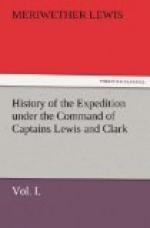April 27. We left the mouth of the Yellowstone. From the point of junction a wood occupies the space between the two rivers, which at the distance of a mile comes within two hundred and fifty yards of each other. There a beautiful low plain commences, and widening as the rivers recede, extends along each of them for several miles, rising about half a mile from the Missouri into a plain twelve feet higher than itself. The low plain is a few inches above high water mark, and where it joins the higher plain there is a channel of sixty or seventy yards in width, through which a part of the Missouri when at its greatest height passes into the Yellowstone. At two and a half miles above the junction and between the high and low plain is a small lake, two hundred yards wide, extending for a mile parallel with the Missouri along the edge of the upper plain. At the lower extremity of this lake, about four hundred yards from the Missouri, and twice that distance from the Yellowstone, is a situation highly eligible for a trading establishment; it is in the high plain which extends back three miles in width, and seven or eight miles in length, along the Yellowstone, where it is bordered by an extensive body of woodland, and along the Missouri with less breadth, till three miles above it is circumscribed by the hills within a space four yards in width. A sufficient quantity of limestone for building may easily be procured near the junction of the rivers; it does not lie in regular stratas, but is in large irregular masses, of a light colour and apparently of an excellent quality. Game too is very abundant, and as yet quite gentle; above all, its elevation recommends it as preferable to the land at the confluence of the rivers, which their variable channels may render




